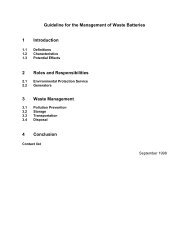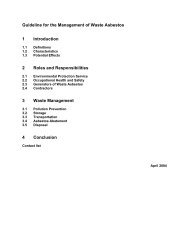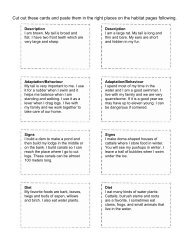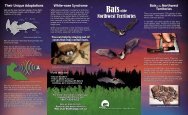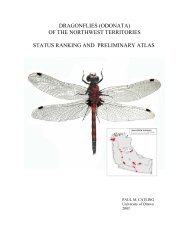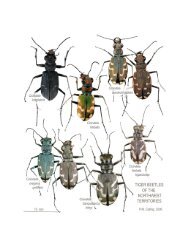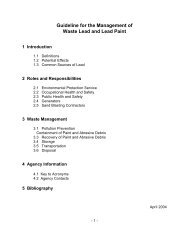Standard Operating Procedure (SOP) - Environment and Natural ...
Standard Operating Procedure (SOP) - Environment and Natural ...
Standard Operating Procedure (SOP) - Environment and Natural ...
- No tags were found...
Create successful ePaper yourself
Turn your PDF publications into a flip-book with our unique Google optimized e-Paper software.
<strong>St<strong>and</strong>ard</strong> <strong>Operating</strong> <strong>Procedure</strong> (<strong>SOP</strong>)<br />
Capture, H<strong>and</strong>ling & Release of Bears<br />
Wildlife Care Committee Primary Author: Dr. Marc Cattet Version 2 - 2011<br />
• Contingency plans <strong>and</strong> required materials (e.g., appropriate dugs)<br />
must be in place to deal with the accidental trapping of non-target<br />
species, e.g., wolf, black bear, moose, etc.<br />
4.1.3 Recommendations for Approach During Live Capture:<br />
Bears immobilized by remote drug delivery must be approached quietly<br />
<strong>and</strong> slowly to assess the animal‟s response to noise <strong>and</strong> touch.<br />
Minimal stimulation of the immobilized bear is critical because peak drug<br />
effects generally occur sometime after immobilization (Caulkett et al. 1994,<br />
Plumb 2002). Excessive stimulation of a lightly anesthetized bear may be<br />
sufficient to cause a physical response, including a return to a mobile state<br />
(Nielsen 1999).<br />
If a helicopter is used, the pilot must be instructed to l<strong>and</strong> a safe distance<br />
from the animal while maintaining clear view of the downed animal.<br />
Although the distance between helicopter <strong>and</strong> bear will be variable depending<br />
on terrain, the goal is to reduce stimulation of the immobilized animal while<br />
maintaining the safety of the capture crew. In some cases, it may be<br />
necessary to l<strong>and</strong> quickly within meters of a downed bear, e.g., the bear has<br />
collapsed in water. In other cases, it may even be possible to l<strong>and</strong> the<br />
helicopter during induction <strong>and</strong> observe the darted animal from a distance<br />
until it becomes immobilized (Roffe et al. 2001).<br />
Only two people should approach the immobilized bear initially. One<br />
person is responsible for assessing the animal while the other person<br />
carries a firearm <strong>and</strong> provides emergency cover for the approach person.<br />
The person carrying the firearm must be familiar with the “normal” behavior of<br />
a drugged bear, in particular, what movements are acceptable, e.g., slight<br />
twitching of limbs, movement of tongue, etc.<br />
During the approach, the helicopter should remain idling <strong>and</strong> other<br />
members of the h<strong>and</strong>ling crew must remain at the helicopter awaiting<br />
instruction from the approach person.<br />
Once the animal is determined to be safely immobilized, the approach person<br />
signals the pilot to shut down the helicopter <strong>and</strong> other members of the<br />
h<strong>and</strong>ling crew to approach.<br />
Bears captured by culvert trap or leg-hold snare should be approached in<br />
the same manner as bears captured by remote drug delivery.<br />
However, the initial approach should only be close enough to allow evaluation<br />
of the security of the restraint <strong>and</strong> the approximate size of the captured<br />
animal. If the captured bear is a dependent young animal (cub-of-year or<br />
yearling), or an adult female possibly accompanied by a consorting male, the<br />
capture crew should leave the immediate trap-site area quickly <strong>and</strong> not<br />
approach again until it is established that no free-ranging bears are in close<br />
vicinity. Assessment of the capture area for the presence of other bears may<br />
require the use of aircraft where tree cover is extensive.<br />
4.1.4 Recommendations for Initial H<strong>and</strong>ling During Live Capture:<br />
14



